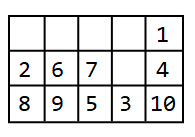The problem is how to determine the repetitive sequences and replace the part with consecutive sequences
For example:
A={{1,3,4},{2,3,5},{1,6}}
Then, detect there are the repetitive case for 1 and 3 and become
A={{1,4,6},{3,5,7},{2,8}}
Updates
Q1:How can I assign the repetitive sequences in lists(transpose tableform) with the rules:
-Highest level & no blocked on the top will be assigned lower number.
-High level with similar repetition will follow later.
-The one underneath the other number will be much later.
A={{2,1},{2,2},{1,2},{1},{2,1,1}};
Print[Rotate[
Grid[Map[Rotate[#, -90 Degree] &, A, {-1}], Frame -> All],
90 Degree]]
And implement the rules to get the output:
Q2:How can I generate all the possible list outcomes without the rules when the lists have repetitive cases?



